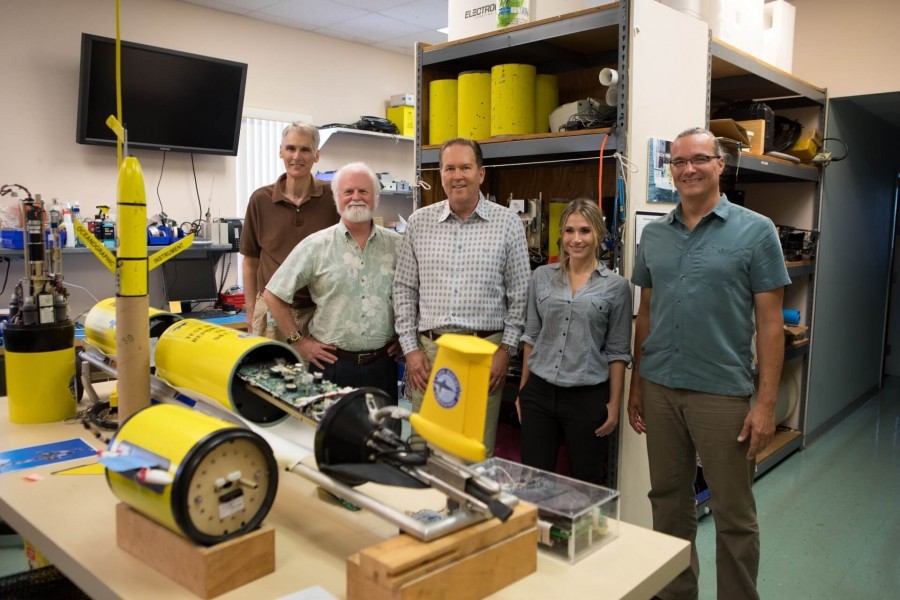Buchanan at Mote Marine Laboratory discusses funding to fight red tide

Congressman Vern Buchanan meets Mote's president and CEO and red tide-focused researchers. Credit Conor Goulding/Mote Marine Lab
Congressman Vern Buchanan visited Mote Marine Laboratory & Aquarium in Sarasota on July 2 to discuss federal funding to fight red tide caused by Karenia brevis algae. The government funding bill signed into law earlier this year included legislation introduced by Buchanan dedicating $8 million to combat red tide, whose toxins are killing fish and impacting beaches along some areas of the Suncoast.
“People visit and move to Florida to enjoy our beautiful natural resources,” said Buchanan. “But the harmful effects of red tide kill sea life, impact human health and cost the economy millions of dollars in lost revenues. We need to understand more about the toxins in red tide so we can stop their damaging effects. The work being done here at Mote will help manage and mitigate the effects of red tide.”
Mote researchers work with the National Oceanic and Atmospheric Administration (NOAA), the Gulf of Mexico Coastal Ocean Observing System, the Florida Fish and Wildlife Conservation Commission, the Florida Department of Health, the University of South Florida, Solutions to Avoid Red Tide and others to investigate Florida's red tide to understand how blooms form, persist and dissipate, how they affect human and animal populations and whether bloom impacts can be mitigated through new methods and technologies.
Buchanan's legislation increased funding for NOAA by $8 million to provide additional resources to reduce the impacts of red tide.
“As a challenging Florida red tide bloom persists along the Gulf Coast, it is appropriate that Congressman Vern Buchanan chose to visit Mote Marine Laboratory’s City Island research campus today to discuss the latest developments in our innovative, red tide-focused science, technology and public outreach programs,” said Mote President & CEO Dr. Michael P. Crosby.
“We recognize Congressman Buchanan for his relentless attention to addressing red tide, and we appreciate that the congressman turned to Mote recently for independent, objective expertise and science-based information as he championed a bipartisan effort resulting in $8 million appropriated to NOAA’s National Ocean Service to fight harmful algal bloom impacts. This meaningful contribution should help the U.S. government take its rightful place in support of much-needed, improved red tide research and mitigation efforts at state and local levels.”
Within the past week, red tide has been detected at background to medium concentrations at many Suncoast beaches, with some locations from Sarasota to Collier counties experiencing high levels. Residents and visitors can Mote's Beach Conditions Reporting System, which provides daily updates on red tide impacts for multiple Gulf Coast beaches, and can report dead fish, respiratory irritation and discolored water by downloading Mote's free CSIC app (Citizen Science Information Collaboration) for iPhones and Android devices. Check ed tide status for weekly statewide reports and mid-week summary reports from the Florida Fish & Wildlife Conservation Commission and statewide partners.
Harmful algae blooms cause $82 million in economic losses to the seafood, restaurant and tourism industries each year in the United States, according to NOAA.
Human consumption of shellfish contaminated with red tide areas can cause severe illness, and people who swim in red tide or inhale its toxins while near the water can suffer respiratory irritation, which can be severe in those with chronic respiratory issues, along with skin irritation and rashes. The state’s health department even advises that people with severe or chronic respiratory conditions like asthma should steer clear of red tide waters.
Buchanan, the co-chair of Florida's congressional delegation, has successfully fought since 2007 for red tide research. The measure was included in the Make America Secure and Prosperous Appropriations Act, which funds the federal government for fiscal year 2018.
Florida-wide red tide resources
- To report fish kills, contact the FWC Fish Kill Hotline at 800-636-0511 or submit a report online.
- FWC’s statewide red tide status reports (on abundance of K. brevis algae) are typically updated every Friday afternoon
- Based on statewide results, the National Oceanic and Atmospheric Administration provides forecasts of potential respiratory irritation
- Mote’s CSIC app allows users to report when and where they experience respiratory irritation or see discolored water or dead fish — all potential indications of Florida red tide.
- Mote’s Beach Conditions Reporting System provides shoreline observations as often as twice daily
- Red tide background info from Mote and FWC (including FAQs)
- Red tide and human health – information and rack cards from Florida Department of Health
- FWC’s red tide offshore monitoring program – a way for volunteers to help.
- FWC-Mote Facebook page, Florida Red Tide and Other Harmful Algal Blooms